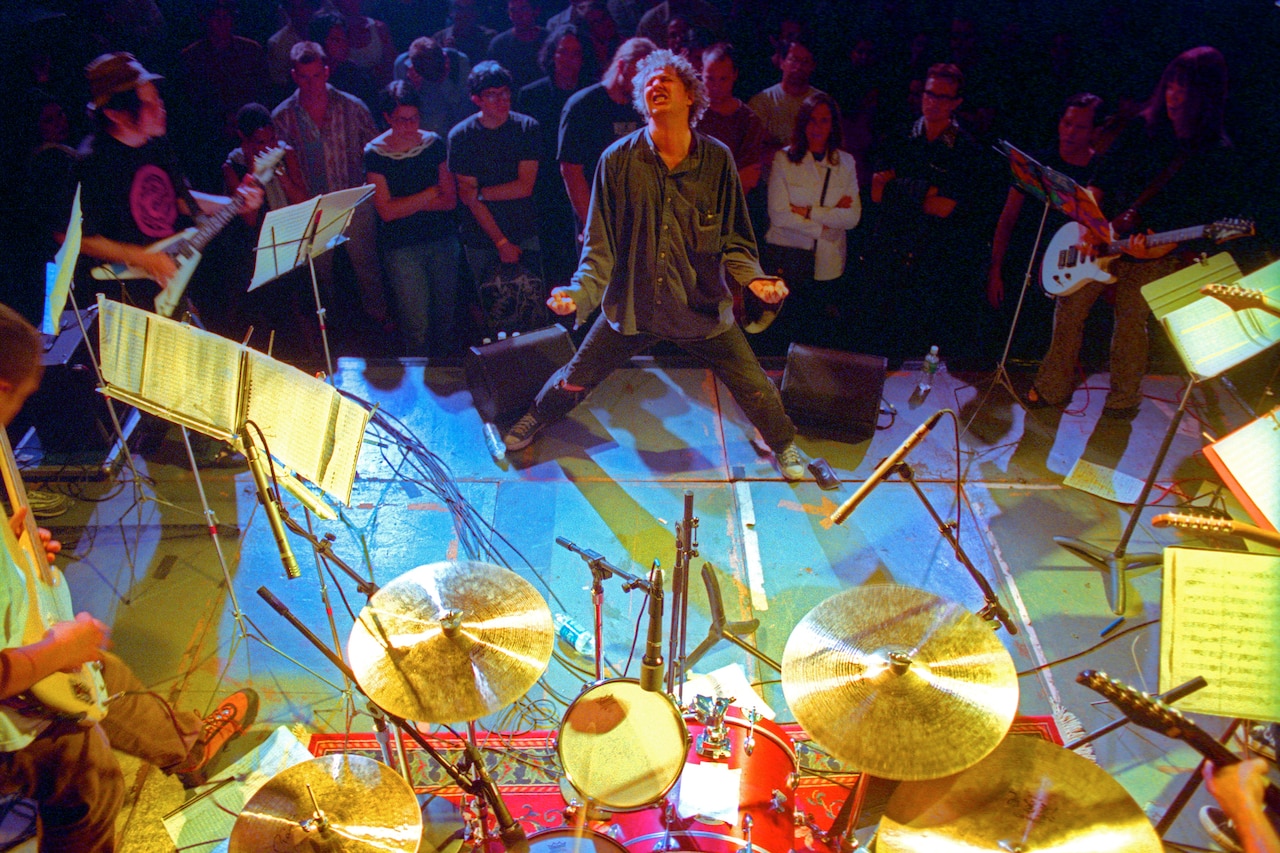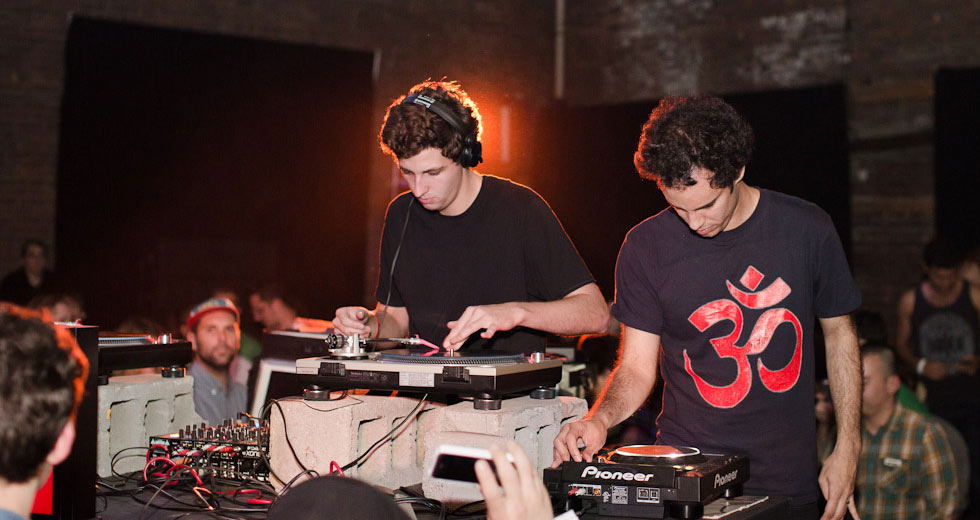
Glenn Branca: A Guide to the Symphonies
To most listeners, composer Glenn Branca is best known for his early engagements with the experimental side of rock history. Back in 1981, Thurston Moore and Lee Ranaldo were two of the guitarists in the orchestra for the premiere of Branca’s Symphony No. 1, and since it was Branca’s own early ’80s imprint, Neutral, that originally released Sonic Youth’s first self-titled EP, the man has been subsumed within that band’s origin story for decades.
Likewise, the composer’s short-lived art rock group Theoretical Girls remains a part of CBGB’s aesthetically wild 1970s legacy – making it much easier for some to talk about Branca as a rock icon than as a symphonic visionary. However, now that the iconic club has been “recreated” both at Newark Airport and on HBO’s Vinyl (and since Sonic Youth’s run appears well and truly over), perhaps it's the right time to tell the Glenn Branca story as something other than a footnote to underground rock lore. (Especially as this summer marks the 35th anniversary of Branca’s Symphony No. 1.)
You have to give Branca credit for dedication: as of this writing, his website details 16 different symphonies. Of those, nine of his first 10 have received official recordings. (While Symphonies Nos. 11, 12, 14 and 15 remain in the ether, the Atavistic label has just issued Symphony No. 13 Hallucination City for 100 Guitars, and plans to issue the long-unreleased Symphony No. 4 later in 2016.) Along with his peer and sometime rival Rhys Chatham, Branca has helped to elevate the once-idiosyncratic idea of music for guitar-centric orchestras to a position that merits consideration by contemporary classical aficionados.
Branca is “the only symphonist whose music does not come in any way from the European tradition.”
In his book American Music in the Twentieth Century, the musicologist and composer Kyle Gann relates Branca’s fascination with mid-20th century modernists like Krzysztof Penderecki, and also observes that the harmonic movement of Branca’s music has an antecedent in the work of the late Romantic composer Anton Bruckner. Still, in Gann’s telling, the structure and logic (not to mention instrumentation) of these pieces makes Branca “the only symphonist whose music does not come in any way from the European tradition.” It’s probably fair to conclude that this originality has something to do with Branca’s youthful fascination with the Kinks, as well as his autodidact’s claim that he learned about composition by sitting in front of feedbacking amplifiers for 45 minutes at a stretch.
Still, Branca’s approach has changed and matured over time. He’s experimented with just intonation, other alternate tunings and psychoacoustic effects (thanks to masses of guitars striking identical pitches). He sometimes works with algorithms to create complex tempo relationships between different instrumental parts. He’s used the harmonic series as a basis for composition – and then steered away from it.
Potent, amplified noise hasn't been his only major compositional tool. Some of his symphonies – like the 7th, 9th and 11th – are meant to be played by traditional orchestras. He's also still composing large-scale opuses outside of the symphonic-guitar idiom: Branca’s website lists a currently in process seven-movement work for 100 violins.
Throughout it all, what has remained constant is Branca’s dramatic talent. He often builds tremendous, swirling masses of sound quickly, without any fear of peaking too soon. In his best passages, he works a surprising change at precisely the moment when you think you have the direction of his composition figured out, or when it seems like any change in the throttling momentum of a work will result in an anti-climax. In advance of the composer’s next announced releases, planned for later in 2016, we offer a subjective guide to the Symphonic Branca catalog that is already on the market.
Symphony No. 1, “Tonal Plexus” (1981)
For multiple guitars, keyboards, brass and percussion
Recorded live at The Kitchen in 1981, this symphony’s opening minutes show how much style Branca can squeeze out of single-pitch strumming. Gradually thickening harmonies in the guitars set the stage for the mid-tempo, rockish percussion that drives much of the first movement. It can sound like a slightly restrained version of small-ensemble Branca pieces from the same period, like “Light Field (In Consonance),” at least until sustained, brilliant tones from the brass section give a hint of Branca’s skill with arrangement and orchestral color.
Symphony No. 2, “The Peak of the Sacred” (1982)
For eight mallet guitars, taped harmonic guitars, bass drums, metal percussion, and drums
Here we have our introduction to Branca the instrument builder. (“There wasn't a single actual guitar in the piece, except for bass,” he told the Village Voice.) This sometimes glacially paced work (76 minutes!) offers a chance to sink into the aesthetic of Branca’s microtonal fascinations – with the sustained, ghostly resonances of his “mallet guitars” making a strong impression during the first movement, titled “Slow Mass.” Branca is still a symphonist in search of a form. But the intensity of his pursuit is thrilling, even when the symphony’s ragtag construction doesn’t hold together – as when post-punk strumming gives way, suddenly, to musique-concrete chain rattling (the latter courtesy of legendary Downtown New York percussionist Z’ev).
Symphony No. 3, “Gloria” (1983)
For modified harpsichords, bass, drums
A dramatic leap forward. The music-theory explanation involves Branca’s flood-the-zone decision to compose with every harmonic of the first seven octaves in the overtone series. That said, the triumph here also has something to do with Branca’s instrument building – this time, he outfitted harpsichords with guitar pickups – and an improved compositional use of time. The powerful drumming doesn’t hit until a quarter hour into the symphony’s first movement. But up until that point, Branca has sustained interest with a faultless feel for the ideal duration of each passing combination of precisely tuned sonorities. And for the first time, the movements feel linked, as opposed to forced together by necessity.
Symphony No. 5, “Describing Planes of an Extended Hypersphere” (1984)
For mallet guitar, guitar, harmonics guitar, modified harpsichord, keyboard, violin, bass, drums
As he did with No. 3, Branca works again with “just intonation” tuning. But unlike the way that “Gloria” frequently presented each sequential harmony after a slight rest, here the first movement cycles through its development via continuously sliding tones – made possible by the reintroduction of conventional and Branca-augmented guitars, as well as other string instruments. This original instrumentarium creates all manner of strange acoustic phenomena, with chords slipping past perception almost as soon as they’ve managed to form. The sound fits the science-fictional mood of the title. (When listening, just picture yourself in a cockpit, floating through alien realms.) Particularly interesting is the three-part, frequently uptempo fifth movement, which has a bit of a self-contained feel – and plenty of kick.
Symphony No. 6, “Devil Choirs at the Gates of Heaven” (1987)
For drums, bass, keyboard, and between eight and ten guitars
This is a highlight of the catalog, as the crisp performance of the guitar orchestra and the recording’s clear sonics are on the same level with Branca’s compositional work. Comparatively delicate strumming and percussion launch the first movement, although by its conclusion, the performers are collaborating on an ecstatic, offbeat groove – perhaps reflecting the lingering influence of the avant-funk pioneered during New York’s no wave years. (More of this can be found at the beginning of the fourth movement.) The closing section makes good on the symphony’s subtitle, with raging clouds of guitar sounding as though they’re howling for entry into a realm where they do not belong.
Symphony No. 7 (1989)
For symphony orchestra
Branca’s first foray into a full symphonic score for a “regular” orchestra has a structurally patchwork feel not unlike his earliest guitar-driven symphonies. He’s trying out ideas and stitching together the experiments. “Shaking Air” owes a little bit to Philip Glass’s early symphonies, while “Freeform” shows Branca’s interest in John Adams’s mature, post-minimalist orchestral style. The two-part “Harmonic Series Chords” works at translating some of the lessons of “Gloria” and “Hypersphere” into a conventional symphonic language (with a good deal of success). There’s even an abstracted, Ives-ian folkiness to the closing movement. The live recording leaves a bit to be desired, but it’s a trip to hear Branca both trying out new ideas and refining some old ones.
Symphony No. 8 “The Mystery” (1992)
For the Glenn Branca Ensemble (guitar-bass-drums sextet)
A return to the electric-guitar-driven orchestra results in a consolidation of past strengths, and some new insights. When more familiar-sounding, consonant harmonies crop up among the guitars, early in the opening movement, it’s almost as if Branca is daring us to think he’s become predictable. Fear not: he’s actually begun employing complex tempo relationships, making the overall beat-patterns difficult to anticipate. (Mysteries, indeed!) As the melodic line on one instrument rises, that of another falls. The quality is miasmatic, recalling a quote that Branca once gave to the critic Gann on the subject of why he considers himself a minimalist: “Minimalism does not progress from left to right. It’s what happens inside the music. I’m trying to allow the music to change organically, so that you have the sense that you’re experiencing the whole piece at once.”
Symphony No. 9 “L’eve future” (1993)
For symphony orchestra and chorus
And then he turns right back around and translates his new tempo-algorithm style into a piece for conventional orchestra and chorus. The end result is some gloriously melancholic and wonderfully ethereal music that you could imagine Baroque-era church composers admiring. (The final cadences harken back to the resolution of “Gloria,” as well.) The musicianship on this recording – which comes courtesy of the Polish Radio National Symphony Orchestra and the Camerata Silesia Singers Ensemble – is excellent.
If the Pulitzer classical committee had been as hip in 1995 as they were in 2015 (the year a Branca fan, Julia Wolfe, won for Anthracite Fields), this might have had a shot at the big prize. In any case, it’s a piece that deserves to be much better known, and perhaps even performed by an American orchestra. The recording, which can be found on an out-of-print Phillips CD, also includes an improved take on “Freeform” (from Symphony No. 7).
Symphony No. 10 “The Mystery, Pt. 2” (1994)
For the Glenn Branca Ensemble (guitar-bass-drums sextet)
Even as it displays some surface-level similarity to the earlier symphonies, the first movement of this compact sequel to No. 8 is newly dense with harmonic and rhythmic activity. And then the second movement gives Branca a chance to devise even more complex polyrhythmic passages. It’s too bad that the current crop of Branca symphonic recordings stops here, as it’s clear that his store of ideas is far from exhausted.
Header image © Hiroyuki Ito/Getty Images

